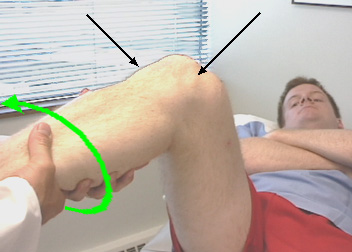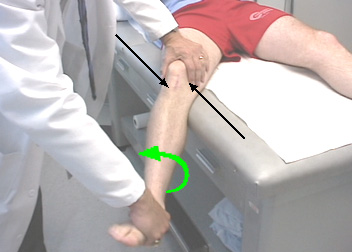Dial Test
Original Editors - Gaelle Vertriest
Lead Editors - Your name will be added here if you are a lead editor on this page. Read more.
Search Strategy[edit | edit source]
Keywords:
Dial test, posterior knee pain, tibial external/internal rotation test, posterolaterale exorotatietest, knee tests, instability tests, knee injury
Databases searched:
Medscape, Pedro, Google Scholar, Pubmed, Cochrane library, Web of Knowledge, Library of the VUB
Definition/Description[edit | edit source]
Purpose[edit | edit source]
The purpose of the ‘Dial Test’ is to diagnose posterolateral instability. By performing the test, we can detect whether there’s an isolated or combined injury of the knee. (2)(4)(7)(12)
An injury to only one or two structures of the knee must be investigated by the dial test, other clinical tests en diagnostic methods. That can be physical examinations, magnetic resonance imaging, radiographs, and patient’s history. For an isolated PCL-tear, the posterior drawer test or sag tests are more provocative. (1)(2)(4)
Clinically Relevant Anatomy[edit | edit source]
The dial test is clinically valuable when three structures are injured. These three posterolateral structures may be the popliteus tendon, the popliteofibular ligament (PFL) and the lateral collateral ligament (LCL). It may also be a combined injury with the posterior cruciate ligament (PCL) and two other posterolateral structures. (2)(4)(8)
Technique
[edit | edit source]
It is possible to do the test both in a prone and supine position, and is performed in both 30° and 90° knee flexion. (1)(2)(9)(13) The dial test inspects the external rotation at the knee joint. (2)(5)(7)(9)
The patient is in prone: performing the test is sensitive to the notice of a PLC-injury in a PCL-injured knee. (2) The knees are held together and bent at 30°, the therapist stands behind the table and keeps the feet in dorsiflexion. He turns the lower legs and feet outwards and compares the motion of the feet. (5)(6) Repeat the test with the knees at 90°. (6)(13)
- www.youtube.com/watch (13)
The patient is in supine: there are 2ways to perform this test.
1) As in prone position: the knees are held together and bent at 30°, the therapist stands behind the table and keeps the feet in dorsiflexion. He turns the lower legs and feet outwards and compares the amount of rotation of the tibial tubercle. Repeat the test with the knees at 90°. (12)(13)
- www.youtube.com/watch (13)
2) One leg is hanging off the edge of the table with the knee in 30° of flexion. The therapist stands beside the table and stabilizes the thigh with one hand; the other hand executes an external rotation of the foot. By observing the tibial tubercle motion, we can indicate any posterolateral knee injury. With an increase, compare to the normal contralateral side. (1)(7) (10)(12)
If the dial test at 30° is positive, perform the test when the knee is flexed on 90°. The thigh does not touch the table, hold the leg in your hands or put the foot down on the table. (7)(11)(12) (11)
(11)
Key Research[edit | edit source]
add links and reviews of high quality evidence here (case studies should be added on new pages using the case study template)
Resources
[edit | edit source]
add appropriate resources here
Evaluation[edit | edit source]
The evaluation of the test for both prone and supine position:
The dial test is positive when there is more than 10° of external rotation in the injured knee compared to the uninjured knee. (2)(3)(9)(10)(12)
| Standard injury | Mild injury | Moderate injury | Severe Injury |
| <5° | 6-10° | 11-19° | >20° |
(6)
There are different injuries:
- An isolated injury to the PLC: more than 10° of external rotation in the injured knee is present at 30° of flexion, but not at 90° of flexion. (1)(2)(6)(3)(7)(9)(11)
- Instability of the PCL: more than 10° of external rotation in the injured knee is present at 90° of flexion, but not at 30° of flexion. (7)(11)
- A combined injury: more than 10° of external rotation in the injured knee is present at 30° and 90° of flexion. This is an injury of the PCL and the PLC. (6)(7)(9)(11)
Recent Related Research (from Pubmed)[edit | edit source]
see tutorial on Adding PubMed Feed
Extension:RSS -- Error: Not a valid URL: Feed goes here!!|charset=UTF-8|short|max=10
References[edit | edit source]
see adding references tutorial.







